WHAT'S GOOD FOR THE GOOSE ...
 It’s always puzzled us why there’s so little fertilization among our communications disciplines.
It’s always puzzled us why there’s so little fertilization among our communications disciplines.
Take the creative brief, for instance.
A staple of advertising agencies, somehow the brief seems to have skipped corporate, public relations agency, and consulting worlds. Outside vendors that take on, for instance, an annual report or the re-do of a Web site may, indeed, pull together some sort of framework that guides the project. It’s considered a necessary (okay, even mandatory) road map, the architecture that not only keeps the messages aligned but the people as well.
When it comes to those internal professionals managing a major deliverable, we haven’t seen that kind of detail. For sure, key messaging will almost definitely be established. But the straightforward language and the thinking behind a brief isn’t always developed. Such as: Brutal honesty about what stakeholders believe and feel. Visual and verbal statements that truly define the brand without ambiguity. And identifying what’s important, what’s not and the metrics involved.
Sure, there are templates to follow. Lots of questions to be answered, from the whats (the project), and whys (reasons for being) to the whens, wheres, and hows.
On the other hand, it’s not a deck or a massive tome. In our heads, a creative brief needs to be true to its definition: something that inspires (creative) and something that’s short (brief).
What’s been your experience, dear readers?
 Tuesday, November 24, 2015 at 12:00PM | in
Tuesday, November 24, 2015 at 12:00PM | in  creative brief
creative brief 



